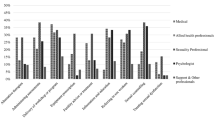Abstract
Historically, the management of sexuality issues in spinal cord injury rehabilitation has received scant attention as a staff training issue. This has occurred despite evidence in the literature identifying significant barriers to the provision of sexuality rehabilitation. This paper reports on a needs assessment conducted within an Australian spinal cord injury rehabilitation service to identify the training needs of staff in relation to client sexuality. Using the Knowledge, Comfort, Approach and Attitudes Towards Sexuality Scale (KCAASS), a previously developed theoretical model and questionnaire, 90 multidisciplinary staff were surveyed. A combination of open and closed questioning techniques were used. While the findings suggest some differences between disciplines, the training needs of the interdisciplinary team were surprisingly similar. Knowledge is required in the areas of counselling, professional boundary setting, fertility and assistive devices while specific training is needed to promote staff comfort in dealing with personal approaches from clients.
Similar content being viewed by others
REFERENCES
Hart KA, Rintala DH, Fuhrer MJ: Educational interests of individuals with spinal cord injury living in the community: Medical, sexuality, and wellness topics. Rehabil Nurs 21:82-90, 1996.
McAlonan S: Improving sexual rehabilitation services: The patient's perspective. Am J Occup Ther 50:826-34, 1996.
Summerville P, McKenna K: Sexuality education and counselling for individuals with a spinal cord injury: Implications for occupational Therapy. Br J Occup Ther 61:275-279, 1998.
Drench ME, Losee RH: Sexuality and sexual capacities of elderly people. Rehabil Nurs 21: 118-123, 1996.
Tepper MS: Providing comprehensive sexual health care in spinal cord injury rehabilitation: Implementation and evaluation of a new curriculum for healthcare professionals. Sex Disabil 15:131-165, 1997.
Christian L, Stinson J, Dotson LA: Staff values regarding the sexual expression of women with developmental disabilities. Sex Disabil 19:283-291, 2001.
Dunn M: Sexual questions and comments on a spinal cord injury service. Sex Disabil 6:126-134, 1983.
Herson L, Hart KA, Gordon MJ, Rintala DH: Identifying and overcoming barriers to providing sexuality information in the clinical setting. Rehabil Nurs 24:148-151, 1999.
Novak PP, Mitchell MM: Professional involvement in sexuality counseling for patients with spinal cord injuries. Am J Occup Ther 42:105-112, 1988.
Kendall M, Booth S, Fronek P, Miller D, Geraghty T: The development of a scale to assess the training needs of professionals providing sexuality rehabilitation following spinal cord injury. Sex Disabil 21:49-64, 2003.
Hodge AL: Addressing issues of sexuality with spinal cord injured persons. Orthop Nurs 14: 21-24, 1995.
Chivers J, Mathieson S: Training in sexuality and relationships: An Australian model. Sex Disabil 18:73-80, 2000.
Haboubi NHJ, Lincoln N: Views of health professionals on discussing sexual issues with patients. Disabil Rehabil 25:291-296, 2003.
Hall P, Weaver L: Interdisciplinary education and teamwork: A long and winding road. Med Educ 35:867-875, 2001.
Freer KJ, Turner R: Participatory workplace literacy training in a hospital setting. J Healthc Educ Train 9:1-6, 1995.
Tagliareni E, Sherman S, Waters V, Mengel A: Participatory clinical education: Reconceptualising the clinical learning environment. Nurs Health Care 12:248-250, 261-263, 1991.
Carr LT: The strengths and weaknesses of quantitative and qualitative research: What method for nursing? J Adv Nurs 20:716-721, 1994.
Gagne JP, McDuff S, Getty L: Some limitations of evaluative investigations based solely on normed outcome measures. J Am Acad Audiol 10:46-62, 1999.
Britton JO, Thomas KR: Rehabilitation counseling practice: Some sociological insights. J App Rehabil Couns 7:34-39, 1976.
Jenner H: The pygmalion effect: The importance of expectancies. Alcohol Treat Q 7:127-133, 1990.
Rosenthal R: Covert communication in classrooms, clinics, courtrooms, and cubicles. Am Psychol 57:839-849, 2002.
Witkin BR, Altschuld JW: Planning and conducting needs assessments: A practice guide. Thousand Oaks CA, Sage, 1995.
Author information
Authors and Affiliations
Rights and permissions
About this article
Cite this article
Booth, S., Kendall, M., Fronek, P. et al. Training the Interdisciplinary Team in Sexuality Rehabilitation Following Spinal Cord Injury: A Needs Assessment. Sexuality and Disability 21, 249–261 (2003). https://doi.org/10.1023/B:SEDI.0000010067.27044.7e
Issue Date:
DOI: https://doi.org/10.1023/B:SEDI.0000010067.27044.7e




